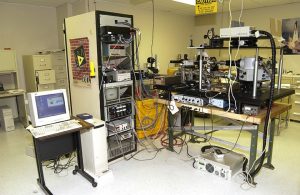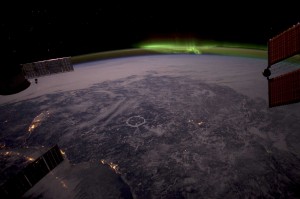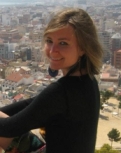
Spann established the Dusty Plasma Laboratory (pictured above) in the mid-90s to learn more about the dust on the surface of the Moon (Photo courtesy of Dr. James Spann).
As one team of scientists at NASA’s Marshall Space Flight Center (MSFC) tests the mirrors and optical structure of the James Webb Space Telescope in anticipation of its launch in 2018 to a point one million miles away from Earth, another team works inside the Dusty Plasma Laboratory, analyzing granulated rock from a place much closer to Earth: the Moon.
Dr. James Spann, the manager of the Office of Science at MSFC, has built a career from rocks and dust. He founded the Dusty Plasma Laboratory with the help of graduate student Catherine Venturini in 1995 in order to solve the vexing problems that lunar dust creates during space exploration.
“Lunar dust grains on the moon are so tiny, they’re almost impossible to get off your clothes, and that’s a problem for astronauts,” he explained. “The Apollo astronauts struggled to zip up their suits.”
The dust statically clung to the astronauts’ suits, ate through their gloves, and scratched the protective lenses of their cameras. The abrasive and corrosive nature of the dust results from its formation: millions of years’ worth of meteorite impacts, cosmic rays, and solar winds slam into large rocks, turning them into minute shards of glass, minerals, and weathered rock.
Spann sought to understand the electrostatic charge of lunar dust due to the incident solar wind and UV radiation, and thereby help mitigate the effect of dust on future space missions.
“Our research measured, for the first time, the ability of lunar dust to gain or lose a charge when exposed to the solar wind conditions that exist at the moon,” he said.
Fifteen years later, the Dusty Plasma Laboratory continues to make new discoveries. Space scientist Dr. Mian Abbas runs the lab, assisted by NASA Postdoctoral Program Fellow Dr. Dragana Tankosic. Their research advances NASA’s understanding of the density, size, and charge distributions of lunar dust; contributes to a deeper understanding of the physics of micro-particles; and helps engineers design more resilient equipment for future space endeavors.
Spann’s vision to use fundamental data from dust to solve a problem in space was inspired by his doctoral and postdoctoral work as an applied researcher.
While studying acid rain at the Univ. of Arkansas, where he earned a PhD in physics under Dr. Charles Richardson, Spann first applied the electrodynamic balance technique he later used to study Moon dust. After leaving Fayetteville, he applied a similar technique as a postdoctoral fellow in the 1980s at the Department of Energy’s (DOE) National Energy Technology Laboratory (NETL) where he studied the response of coal slurry droplets to intense laser-heating.
“We were able to map the projected temperature that a coal combustor needed to reach in order for coal droplets to explosively boil,” recalled Spann. “If the droplet did not explosively boil, the coal powder simply coagulated into one giant clump of coal, which would not burn very effectively.”
Spann’s research at NETL helped the DOE efficiently design coal-burning combustion plants, and it prepared him for his next federal research position, this time at NASA. There, he helped the Atmospheric Laboratory of Applications and Science (ATLAS) mission measure high altitude atmospheric and ionospheric emissions and then investigated aurorae on the NASA Polar Mission using the Ultraviolet Imager camera built and tested under his supervision.
Spann was surprised to learn that the significance of the research he was doing for NASA was much more difficult to convey than that of his research at NETL.

Spann studied polar aurorae, like this one taken by Astronaut Don Pettit from the International Space Station (Credits: Don Pettit).
“At NETL, it was easy to explain the value of the research to the taxpayer. We were addressing ways to burn coal more efficiently. At NASA, I was building a camera to image the aurora—those pretty lights in the North and South Pole—and the reaction was `so what?’ Well, there was a strong answer to ‘so what’—a strong reason to be doing it, but it wasn’t as tangible as the purpose of my research for DOE.”
In fact, imaging aurorae provides insight into weather in the near-Earth region of space – the area of space all modern communications rely upon. But Spann thinks of “so what?” in grander, more philosophical terms, too.
“We as humans are naturally curious and love to explore what we do not know. We’re always pressing the boundaries of knowledge. History shows that societies or cultures that quit doing that end up not progressing and eventually are overtaken by others who do,” he said. “NASA is one of the prime expressions of the human trait [of curiosity], and to deny that trait means we are impacting our future—for the worse.”
Spann considers research conducted at NASA, at other federal agencies, and by scientists across the world as necessary for preserving humanity in the long-term and bolstering it in the short-term. The insights and knowledge gathered from research, after all, are commonly funneled into life on eErth.
“There are a ton of spinoffs from NASA research and technological development we use in our society every day,” explained Spann. “A lot of microtechnologies—like charge-coupled device (CCD) censors in cameras or microelectronics integrated into pacemakers—were driven by NASA’s need to develop electronics to go into space that were much smaller and more efficient.”
In his current role as a manager at MSFC, Spann is an advocate for postdoctoral fellowships, internships, and other research experiences that create paths to professional success.
“More than half of the scientists I manage were postdoctoral Fellows at one point,” he said. “I look very closely at our own ORAU Fellows, because in a lot of ways the fellowship is like an interview. Over the course of two years, they prove themselves by demonstrating their expertise and capability to lead their own research.”
Whether inside MSFC under lights powered by coal or outside under the glow of Moon, Spann can easily recognize the value he has contributed throughout his own life as a scientist. Illuminated by success, his journey of scientific discovery continues on.
 Michelle reports on the achievements of participants supported by the Science Education Programs office of Oak Ridge Associated Universities (ORAU), a nonprofit consortium of Ph.D.-granting institutions that cultivates collaborative partnerships for scientific research. Michelle loves writing, traveling and the outdoors and enjoys freelancing for a variety of publications concerning science, the environment and human health and culture. She is a graduate of the Science Communication Program at the University of Tennessee.
Michelle reports on the achievements of participants supported by the Science Education Programs office of Oak Ridge Associated Universities (ORAU), a nonprofit consortium of Ph.D.-granting institutions that cultivates collaborative partnerships for scientific research. Michelle loves writing, traveling and the outdoors and enjoys freelancing for a variety of publications concerning science, the environment and human health and culture. She is a graduate of the Science Communication Program at the University of Tennessee.
LinkedIn: http://www.linkedin.com/pub/
































![A trajectory analysis that used a computational fluid dynamics approach to determine the likely position and velocity histories of the foam (Credits: NASA Ref [1] p61).](http://www.spacesafetymagazine.com/wp-content/uploads/2014/05/fluid-dynamics-trajectory-analysis-50x50.jpg)



Leave a Reply